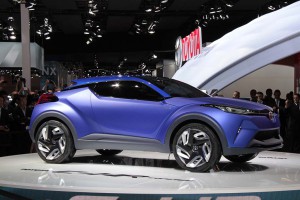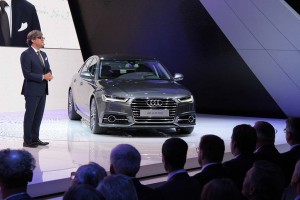Audi is making plenty of news at this year’s Paris Motor Show, including the debut of its 400-horsepower TT Sportback Concept, but at the other end of the display, the German maker has unveiled the new A6 Ultra, a new version of its popular, midsize sedan line that can deliver up to 56 miles per gallon, a number normally associated with smaller hybrid models.
With gas prices running as high as $9 a gallon in parts of Europe, motorists have put a premium on fuel efficiency, but regulators are about to ratchet up the pressure even further. European automotive rules focus on grams per kilometer of carbon dioxide emissions, rather than miles per gallon, and what is already the world’s toughest mandate could soon get a lot tougher.
The current rule calls for European automakers to cut the carbon dioxide emissions of their typical vehicle to just 95 grams per kilometer by 2020 – roughly equal to the 54.5 mpg CAFE standard that will go into effect in the U.S. by 2025. But regulators are giving serious thought to lowering emissions levels to just 65 to 75 g/km.
Martin Winterkorn, the CEO of Volkswagen, has warned such a move could be “fatal” to the auto industry, but his company has already begun looking for ways to meet such a strict standard. And so have a number of other makers, as the Paris Motor Show demonstrates.
This year’s industry showcase features a record number of both conventional and plug-in hybrids, with plenty of concept vehicles hinting at what’s still to come.
Toyota, for example, is showing off the C-HR crossover, which it describes as a “concept driven by the European market.”
“To us, Toyota equals hybrid and hybrid equals Toyota,” said Karl Schlicht, the executive vice president of Toyota Europe, noting that the C-HR features the latest version of the Japanese maker’s Hybrid Synergy Drive, and should deliver a significant bump in fuel economy.
French carmakers are looking to make a splash of their own at their home show. Citroen, for one, is displaying its C4 Cactus Airflow 2L concept vehicle. About the size of a Ford Focus, but weighing as little as a Mazda Miata, it uses only two liters of fuel to travel 100 kilometers. In U.S. terms, that translates into 141 miles per gallon.
Rival Renault goes even further – about 90 miles per gallon further with the Eolab plug-in hybrid concept rated at 235 mpg – and 37 miles per charge of its lithium-ion battery pack.
That’s actually a bit short of what Volkswagen pulled off with the 261 mpg XL1 diesel plug-in. And VW actually is building the ultracar, albeit only 250 copies at around $170,000 apiece.
(New crossovers could blur lines between Jaguar, Land Rover. For more, Click Here.)
Such ultracars traditionally trade off performance for fuel economy. But a tour of the Paris show reveals that environmentally friendly powertrains don’t always have to be stone ponies.
Volkswagen has tweaked the platform used for the XL1 and come up with the new XL Sport, a two-seater using a Ducati twin, the world’s most powerful two-cylinder engine. The German maker claims it can hit 60 in just 5.8 seconds, on the way to a top speed of 168 mph. Fuel economy hasn’t been released, but it’s expected to more than meet the proposed European Union rules. And VW plans to put the XL Sport into production – though as with the XL1, only 250 copies will be built.
(Click Here for details on GM’s recall of 524,000 vehicles.)
High performance manufacturers could be particularly at risk if Europe further tightens CO2 standards. So, with their very survival at stake, exotic brands like Ferrari and McLaren have been adopting new strategies – both borrowing the hybrid systems developed for Formula One for their flagship LaFerrari and P1 models.
(To see more about new European clean air rules for automakers, Click Here.)
Lamborghini’s Paris centerpiece is the Asterion LPI-4 show car, a plug-in hybrid that could get as much as 31 mpg on battery power alone. But combining the output of its three electric motors and 5.2-liter V-8, the Asterion can also pump out a peak 907 horsepower, making it the most powerful car the Italian brand has ever developed.
While there are no firm production plans, Lambo officials made it clear battery power will have to find a place in its line-up going forward. The maker has long focused on dropping its 0 to 60 times as low as possible and now, like more mainstream competitors, it will also need to focus on lowering its fuel consumption and carbon dioxide numbers, as well.


